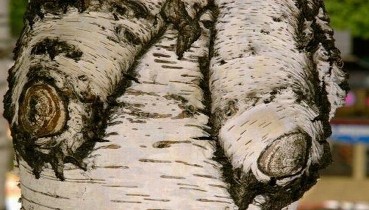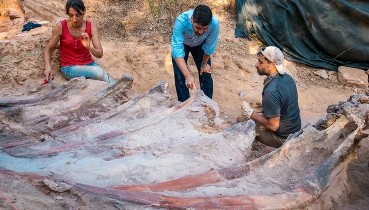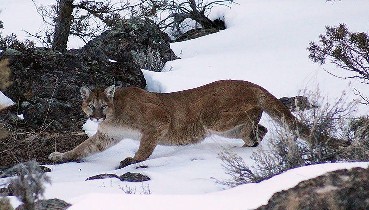

101 Incredible Rock Formations Around the World
Mother Nature truly amazes me sometimes. The other day I stumbled across a picture of a mountain, one side of this mountain had a rock face that had been delicately sculpted by the wind and rain over millions of years to form what could be described as the perfect art form.
My curiosity was sparked so off I went in search of more of these natural rock masterpieces. Low and behold after hours of searching I discovered a plethora of these majestic forms.
I decided to put this post together to share my discoveries and piece together what is hopefully the most comprehensive list of incredible rock formations out there.

1. Danxia Landform
These formations of different colored sandstone were shaped after thousands of years of rain and wind, and the region has been listed as a UNESCO World Heritage site since 2010.

2. Uluru/Ayers Rock
Uluru, also known as Ayers Rock is a large sandstone rock formation in the southern part of the Northern Territory in central Australia. It is listed as a UNESCO World Heritage Site.

3. Preikestolen (Pulpit Rock)
Preikestolen aka Pulpit Rock is a massive cliff in Forsand, Ryfylke, Norway. Each year it is visited by between 150,000 and 200,000 people, making it one of the most visited natural tourist attractions in Norway.

4. Cappadocia
Cappadocia lies in eastern Anatolia, in the center of Turkey. The relief consists of a high plateau pierced by volcanic peaks.

5. Antelope Canyon
Antelope Canyon is the most visited and photographed slot canyon in the American Southwest. It is located on Navajo land near Page, Arizona.

6. Torres del Paine
The Torres Paine (Spanish for “Towers of Paine”) is a National Park in Patagonian Chile famously known for three immense rock towers give the park its name.

7. Giant’s Causeway
The Giant’s Causeway is an area of about 40,000 interlocking basalt columns, the result of an ancient volcanic eruption. It is located on the northeast coast of Northern Ireland, about three miles (4.8 km) northeast of the town of Bushmills.

8. Moeraki Boulders
The Moeraki Boulders are unusually large and spherical boulders lying along a stretch of Koekohe Beach between Moeraki and Hampden in New Zealand.

9. Kyaiktiyo Pagoda (Golden Rock)
Kyaiktiyo Pagoda, also known as Golden Rock, is a well-known Buddhist pilgrimage site in Mon State, Myanmar. According to legend, the Golden Rock itself is precariously perched on a strand of the Buddha’s hair.

10. Half Dome
Half Dome is a granite dome in Yosemite National Park, located in northeastern Mariposa County, California. It is possibly Yosemite’s most familiar rock formation.

11. Ko Tapu
Ko Tapu is a tall islet which is a part of Ao Phang Nga National Park in southern Thailand. In 1974 Ko Tapu was shown in the James Bond movie – “The Man with the Golden Gun”, since it is also known as James Bond Island.

12. Zuma Rock
Zuma Rock is a large monolith located in Niger State, Nigeria. It is immediately north of Nigeria’s capital Abuja, along the main road from Abuja to Kaduna, and is sometimes referred to as “Gateway to Abuja”.

13. Savandurga
Savandurga is a hill 60 km west of Bangalore (Karnataka) off the Magadi road in India. The hill is considered to be among the largest monolith hills in Asia.

14. Sugarloaf Mountain
Sugarloaf Mountain is a peak situated in Rio de Janeiro, Brazil, at the mouth of Guanabara Bay on a peninsula that sticks out into the Atlantic Ocean.

15. El Peñón de Guatapé
El Peñón de Guatapé is a monolithic formation located at the town and municipality of Guatapé (86 km northeast of Melín or 2 hours by bus) in Antioquia, Colombia.

16. Stawamus Chief
The Stawamus Chief (often referred to as simply The Chief) is a granite dome located adjacent to the town of Squamish, British Columbia.

17. Tanah Lot
Tanah Lot is a rock formation off the Indonesian island of Bali. It is the home of a pilgrimage temple, the Pura Tanah Lot and a popular tourist attraction.

18. Hvítserkur
Hvítserkur is a 15-meter-high basalt rock formation located by the eastern shore of Vatnsnes in Iceland.

19. Wadi Rum
Wadi Rum, also known as The Valley of the Moon is a valley cut into the sandstone and granite rock in southern Jordan to the east of Aqaba. It is the largest wadi in Jordan.

20. Peñón de Ifach
The Peñón de Ifach is a massive limestone outcrop emerging from the sea in Calp, (near Valencia) Spain. It is linked to the shore by rock debris and is a nesting site for colonies of sea birds and other birds.

21. Árbol de Piedra
Árbol de Piedra “Stone Tree” is an isolated rock formation in the Eduardo Avaroa Andean Fauna National Reserve of Sur Lípez Province, Bolivia.

22. El Capitan
El Capitan is a vertical rock formation in Yosemite National Park, located on the north side of Yosemite Valley, near its western end. The granite monolith extends about 3,000 feet (900 m) from base to summit along its tallest face and is one of the world’s favorite challenges for rock climbers and BASE jumpers.

23. Mother and Child Balancing Rocks
The impressive Balancing Rock formation in the Motabo Hills, Zimbabwe resembles a ”Mother and her Child”.

24. Monument Rocks
Monument Rocks are a series of large chalk formations in Gove County, Kansas, rich in fossils. It is a National Natural Landmark.

25. Turtle Rock
Turtle Rock is a famous rock formation in the Gorkhi-Terelj National Park in Mongolia. It is popular with tourists and especially rock climbers.

26. White Desert
The White Desert of Egypt is located north of the town of Farafra. The desert has a white, cream color and has massive chalk rock formations that have been created as a result of the occasional sandstorm in the area.

27. Roque de Agando
Roque de Agando is a prominent rock formation on the island of La Gomera in the Canary Islands. It is one of La Gomera’s most striking features and is frequently used as a symbol for the island.

28. Tsingy Rouge
The Tsingy Rouge (Red Tsingy) is a stone formation of red laterite formed by erosion. It is situated approximately 60 km south of Antsiranana near the town of Sadjoavato in northern Madagascar.

29. Bryce Canyon
Bryce Canyon is not a canyon but a collection of giant natural amphitheaters in southwestern Utah in the United States. Bryce is distinctive due to geological structures called hoodoos, formed by frost weathering and stream erosion of the river and lake bed sedimentary rocks.

30. Sigiriya
Sigiriya (also known as Lion Rock) is located in the central Matale District of the Central Province, Sri Lanka in an area dominated by a massive column of rock nearly 200 meters high.

31. Yehliu Geopark
Yeliu Geopark is on the cape of the town of Wanli, New Taipei, Taiwan. Known by geologists as the Yeliu Promontory, forms part of the Daliao Miocene Formation. A number of rock formations have been given imaginative names based on their shapes.

32. Wave Rock
Wave Rock is a natural rock formation that is shaped like a tall breaking ocean wave. It forms the north side of a solitary hill, which is known as “Hyden Rock.” This hill, which is a granite inselberg, lies about 3 km (2 mi) east of the small town of Hyden and 296 km (184 mi) east-southeast of Perth, Western Australia.

33. Brimham Rocks (Idol Rock)
Brimham Rocks are balancing rock formations on Brimham Moor in North Yorkshire, England. The most well-known rock formation being Idol Rock (pictured).

34. Devil's Marbles
The Devil's Marbles are located south of Tennant Creek area of the Northern Territory in Australia. Karlu Karlu as they were originally known is of great cultural and spiritual significance to local Aboriginal people and is one of the oldest religious sites in the world.

35. Drangarnir
Drangarnir is the collective name for two sea stacks between the islet Tindhólmur and the island Vágar in the Faroe Islands.

36. Katskhi Pillar
The Katskhi Pillar is a natural limestone monolith located at the village of Katskhi in western Georgia.

37. Devils Tower
Devils Tower is an igneous intrusion or laccolith in the Black Hills near Hulett, northeastern Wyoming, United States. Devils Tower was the first declared United States National Monument, established on September 24, 1906.

38. Kjeragbolten
Kjeragbolten is a boulder wedged in a mountain crevasse, suspended above a 984-meter deep abyss. It is a popular tourist destination and is accessible without any climbing equipment located in the Kjerag mountain in Rogaland, Norway.

39. Aso Rock
Aso Rock is a large outcrop that is on the outskirts of Abuja, the capital of Nigeria. The Aso Rock is a 400-meter monolith and is the city’s most noticeable feature.

40. Moon Hill
Moon Hill is a hill with a natural arch through it just outside Yangshuo in southern China’s Guangxi autonomous region. It is so named for a wide, semicircular hole through the hill, all that remains of what was once a limestone cave formed in the phreatic zone. most formations in the region, it is karst.

41. Metéora
The Metéora (“middle of the sky”) is one of the largest and most important complexes of Eastern Orthodox monasteries in Greece, second only to Mount Athos.

42. Arches National Park
Arches National Park is a U.S. National Park in eastern Utah. The park is located on the Colorado River just north of Moab. It is known for preserving over 2000 natural sandstone arches, including the world-famous icate Arch, in addition to a variety of unique geological resources and formations.

43. The Twelve Apostles
The Twelve Apostles is a collection of limestone stacks off the shore of the Port Campbell National Park, by the Great Ocean Road in Victoria, Australia. Their proximity to one another has made the site a popular tourist attraction.

44. As Catedrais Beach
As Catedrais beach translates as “Beach of the Cathedrals”. It is the touristic name of Praia de Augas Santas. The Spanish beach is located in the Ribadeo municipality on the Cantabric coast.

45. Belogradchik Rocks
The Belogradchik Rocks are a group of strange shaped sandstone and conglomerate rock formations located on the western slopes of the Balkan Mountains near the town of Belogradchik in northwest Bulgaria. The Belogradchik Rocks have been declared a Natural Landmark by the Bulgarian government and are a major tourist attraction in the region.

46. Flowerpot Island
Flowerpot Island is an island in Georgian Bay, in the Canadian province of Ontario and is a part of Fathom Five National Marine Park. The name of the island comes from two rock pillars on its eastern shore, which lo like flower pots.

47. Torghatten
Torghatten is a mountain on Torget island in Brønnøy municipality in Nordland county, Norway. It is known for its characteristic hole, or natural tunnel, through its center. It is possible to walk up to the tunnel on a well-prepared path, and through it on a natural path.

48. Chiricahua National Monument
Chiricahua National Monument is a unit of the National Park Service located southeast of Willcox, Arizona in the United States. It is famous for its extensive vertical rock formations.

49. Manpupuner
The Manpupuner rock formations or the Seven Strong Men Rock Formations are a set of 7 gigantic abnormally shaped stone pillars located west of the Ural mountains in Russia.

50. The Three Sisters
The Three Sisters are a rock formation in the Blue Mountains of New South Wales, Australia. They are close to the town of Katoomba and are one of the Blue Mountains’ best-known sites, towering above the Jamison Valley. Their names are Meehni, Wimlah, and Gunnedoo.

51. Zhangjiajie National Forest Park
Zhangjiajie National Forest Park is a 243-square mile park is full of stunning karst pillars of sandstone, covered with sub-tropical rainforest. The park is often covered in fog, adding to the mystery but obscuring views.

52. Morro Rock
Morro Rock is a volcanic plug located just offshore from Morro Bay, California, at the entrance to Morro Bay Harbor. A causeway connects it with the shore, effectively making it a tied island.

53. Rock of Gibraltar
The Rock of Gibraltar is a monolithic limestone promontory located in the British overseas territory of Gibraltar, off the southwestern tip of Europe on the Iberian Peninsula.

54. The Pinnacles
The Pinnacles are limestone formations contained within Nambung National Park, near the town of Cervantes, Western Australia. The area receives over 250,000 visitors a year.

55. Percé Rock
Percé Rock is a huge sheer rock formation in the Gulf of Saint Lawrence on the tip of the Gaspé Peninsula in Quebec, Canada, off Percé Bay.

56. The Wave
The Wave is a sandstone rock formation located on the slopes of the Coyote Buttes near the Arizona-Utah border in the United States of America. It is famous among hikers and photographers for its colorful, undulating forms, and the rugged, trackless hike required to reach it.

57. Hạ Long Bay
Hạ Long Bay is a UNESCO World Heritage Site, and a popular travel destination, located in Quảng Ninh Province, Vietnam. The bay features thousands of limestone karsts and isles in various sizes and shapes.

58. Scotts Bluff National Monument
Scotts Bluff National Monument in western Nebraska includes an important 19th-century landmark on the Oregon Trail and Mormon Trail. The monument is composed of five rock formations named Crown Rock, Dome Rock, Eagle Rock, Saddle Rock, and Sentinel Rock.

59. Seven Colored Earths
The Seven Colored Earths are a geological formation and prominent tourist attraction found in the Chamarel plain of the Rivière Noire District in south-western Mauritius.

60. Bucegi Sphinx
The Sphinx is a natural rock formation in the Bucegi Mountains in Romania. It is located at an altitude of 2,216 meters (7,270 ft), a 10-minute walk from the Babele.

61. Ball’s Pyramid
Ball’s Pyramid is an erosional remnant of a shield volcano and caldera that formed about 7 million years ago. It lies 20 kilometers (12 mi) southeast of Lord Howe Island in the Pacific Ocean. It is 562 meters (1,844 ft) high, making it the tallest volcanic stack in the world.

62. Pedra da Gávea
Pedra da Gávea is a mountain in Tijuca Forest, Rio de Janeiro, Brazil. Composed of granite and gneiss, its elevation is 844 meters (2,769 ft), making it one of the highest mountains in the world that end directly in the ocean.

63. Looking Glass Rock
Looking Glass Rock is a pluton monolith in the Appalachian Mountains of western North Carolina. Named for the way its granite face reflects the sunshine, it rises from the valley floor to an elevation of almost 4000 ft.

64. Te Whanganui-A-Hei (Cathedral Cove)
Te Whanganui-A-Hei (Cathedral Cove) Marine Reserve is on the Coroman Peninsula in New Zealand. The cove contains shapely natural rock stacks, Te Hoho Rock and Sphinx Rock in nearby Mare’s Leg Cove.

65. Stone Forest
The Stone Forest is a notable set of limestone formations located near Shilin approximately 120 km (75 mi) from the provincial capital Kunming, China. The tall rocks seem to emanate from the ground in the manner of stalagmites, with many loing like petrified trees thereby creating the illusion of a forest made of stone.

66. Remarkable Rocks
Perched above the sea in Flinders Chase National Park on Kangaroo Island, Australia the impressive Remarkable Rocks form what appears to be a cluster of precariously balanced granite boulders.

67. Natural Arches of the Ennedi
The Ennedi Range of Chad is a beautiful part of the Sahara Desert in the northeastern section of the country of Chad. Travel to this area is difficult and dangerous due to the country’s poverty, lack of tourist facilities, political unrest, and highway banditry. The Ennedi contains hundreds of natural arches, few of which are documented.

68. Chimney Rock
Chimney Rock is a prominent geological rock formation in Morrill County in western Nebraska. During the middle 19th century it served as a landmark along the Oregon Trail, the California Trail, and the Mormon Trail, which ran along the north side of the rock.

69. Azure Window
The Azure Window is a natural arch in the Maltese island of Gozo featuring a table-like rock over the sea. It is situated near two other famous natural landmarks – the Inland Sea, and Dwejra Bay. The stunning geography of the area was created thousands of years ago when two limestone caves collapsed.
UPDATE: During a storm on the 8th of March 2017 the arch collapsed.

70. Externsteine
The Externsteine is a distinctive rock formation located in the district of Lippe within the German state of North Rhine-Westphalia, not far from the city of Detmold at Horn-Bad Meinberg. The formation consists of several tall, narrow columns of rock which rise abruptly from the surrounding wooded hills.

71. Kannesteinen
Kannesteinen is a special stem-shaped stone located on the shore in village Oppedal on the west side of Vaagso in Sogn og Fjordane, Norway. The stone is about 3 feet tall and attracts many tourists, especially in summer.

72. Ben Amera
Ben Amera is the world’s third-largest monolith behind mount Augustus and Uluru, both in Australia. It is located in Mauritania, close to the border with Western Sahara.

73. Mexican Hat
Mexican Hat is a rock formation on the San Juan River in south-central San Juan County, Utah, United States. The name “Mexican Hat” comes from its sombrero-like shape.

74. Peña de Bernal
Peña de Bernal is one of the tallest monoliths in the world located in San Sebastián Bernal, a small town in the Mexican state of Querétaro. Many people make a pilgrimage to the highest point hikeable, visiting a little chapel about halfway up.

75. Trolltunga
Trolltunga is a piece of rock “hanging” horizontally out of the mountain about 700 meters above the Ringedalsvatnet in Skjeggedal, Norway. The name translated to English is The Troll’s tongue.

76. Massif de la Chartreuse
Situated in the Chartreuse mountains la Tour Percée is a unique double arch and at 32 meters the longest span in the Alps. The existence of this arch was only documented in 2005.

77. Dun Briste
Dun Briste is an impressive sea-stack, estimated to be approximately 50 meters in height, and stands 80 meters off Downpatrick Head, in the town of Knockaun, east of Ballycastle, Ireland.

78. Strombolicchio
Strombolicchio is a sea stack of volcanic origin 2 km (1.2 mi) to the northeast of the island of Stromboli in the Aeolian Islands of Italy. A lighthouse is located on its summit; it can be reached by a concrete stairway of over 200 steps.

79. Étretat
Étretat is a commune in northern France. best known for its cliffs, including three natural arches and the pointed “needle”. Two of the three famous arches are seen from the town, the Porte d’Aval, and the Porte d’Amont. The Manneporte is the third and the biggest one, and cannot be seen from the town.

80. Courthouse and Jail Rocks
Courthouse and Jail Rocks are two rock formations located near Bridgeport in the Nebraska Panhandle. The pair of rock formations served as a landmark along the trails for many pioneers traveling west in the 19th century.

81. Bass Rock
The Bass Rock, or simply The Bass, is an island in the outer part of the Firth of Forth in the east of Scotland. The rock is currently uninhabited, but historically has been settled by an early Christian hermit, and later was the site of an important castle.

82. Sibebe
Sibebe is a granite mountain in Swaziland, located 10 km from the capital city Mbabane. It is the second-largest monolith in the world and the largest exposed granite pluton, rising 350m above the valley of the Mbuluzi River.

83. Sail Rock
Sail Rock or Parus Rock is a natural sandstone monolith located on the shore of the Black Sea, in Krasnodar Krai, Russia. It resembles the out of a ship’s sail, hence its name.

84. Pigeons’ Rock
Off the coast of Raouché, there is a natural landmark called the Pigeons’ Rock (also known as the Rock of Raouché). Located at Beirut’s westernmost tip, the two huge rock formations, which stand like gigantic sentinels, are a popular destination for locals and visitors alike.

85. Navajo Twin Rocks
Navajo Twin Rocks is a natural rock formation which is located near the town of Bluff in the State of Utah in the United States.

86. Old Harry Rocks
The Old Harry Rocks are three chalk formations, including a stack and a stump, located at Handfast Point, on the Isle of Purbeck in Dorset, southern England.

87. Kata Tjuta
Kata Tjuta, also known as The Olgas, is a group of large domed rock formations or bornhardts located about 365 km (227 mi) southwest of Alice Springs, in the southern part of the Northern Territory, central Australia.

88. Kicker Rock
Kicker Rock is a landmark destination in the Galapagos Islands. Standing over 140 meters, the two volcanic towers jut out of the ocean off the west coast of San Cristóbal Island.

89. Bungle Bungles
The Bungle Bungles is the landform that is the major component of the Purnululu National Park in Western Australia. The distinctive beehive-shaped towers are made up of sandstones and conglomerates (rocks composed mainly of pebbles and boulders and cemented together by finer material).

90. Old Man of Hoy
The Old Man of Hoy is a red sandstone stack, perched on a plinth of basalt rock. It stands close to Rackwick Bay on the west coast of the island of Hoy, in the Orkney Islands, Scotland, and is a distinctive landmark seen from the Thurso to Stromness ferry. From certain angles, it is said to resemble a human figure.

91. Haystack Rock
Haystack Rock is a 235-foot (72-meter) sea stack in Cannon Beach, Oregon. It is sometimes claimed locally to be the third-tallest such “intertidal” (meaning it can be reached by land) structure in the world, but there are no scientific references to support this.

Recommended Videos
 101 Times Dresses Looked So Bad10325 views
101 Times Dresses Looked So Bad10325 views The bearded reedling (Panurus biarmicus) is a small, sexually dimorphic reed-bed passerine bird5683 views
The bearded reedling (Panurus biarmicus) is a small, sexually dimorphic reed-bed passerine bird5683 views-
Advertisements
 Photographer Is Left In Awe Seeing Mother Goose Care For 47 Goslings And Keep Them All Safe617 views
Photographer Is Left In Awe Seeing Mother Goose Care For 47 Goslings And Keep Them All Safe617 views Meet The Fire Snail, The Rare Red & Black Slug From Malaysia74 views
Meet The Fire Snail, The Rare Red & Black Slug From Malaysia74 views Funny And Cute Photos Of Animals (31 New Pics)1725 views
Funny And Cute Photos Of Animals (31 New Pics)1725 views 27 Unique Trees That Definitely Look Like Something Else..1462 views
27 Unique Trees That Definitely Look Like Something Else..1462 views Man Finds Skeleton in His Backyard – Turns Out It’s the Largest Dinosaur Ever Found in Europe92 views
Man Finds Skeleton in His Backyard – Turns Out It’s the Largest Dinosaur Ever Found in Europe92 views Be Careful, Deer Hunters! Rare Mountain Lion Sighting Confirmed In Southwest Arkansas64 views
Be Careful, Deer Hunters! Rare Mountain Lion Sighting Confirmed In Southwest Arkansas64 views
You may also like
 Unveiling the Innovation of Fruit Stacking: Transforming Agriculture and Business
Unveiling the Innovation of Fruit Stacking: Transforming Agriculture and Business  18 Vintage Photos of a Young Jamie Lee Curtis From the Late 1970s to the '80s
18 Vintage Photos of a Young Jamie Lee Curtis From the Late 1970s to the '80s  I Take Photos Of People And Animals To Show The Natural Beauty Among Them (50 Pics)
I Take Photos Of People And Animals To Show The Natural Beauty Among Them (50 Pics)  The German Society For Nature Photography Has Chosen The Best Wildlife Photographs In Europe (30 Pics)
The German Society For Nature Photography Has Chosen The Best Wildlife Photographs In Europe (30 Pics)